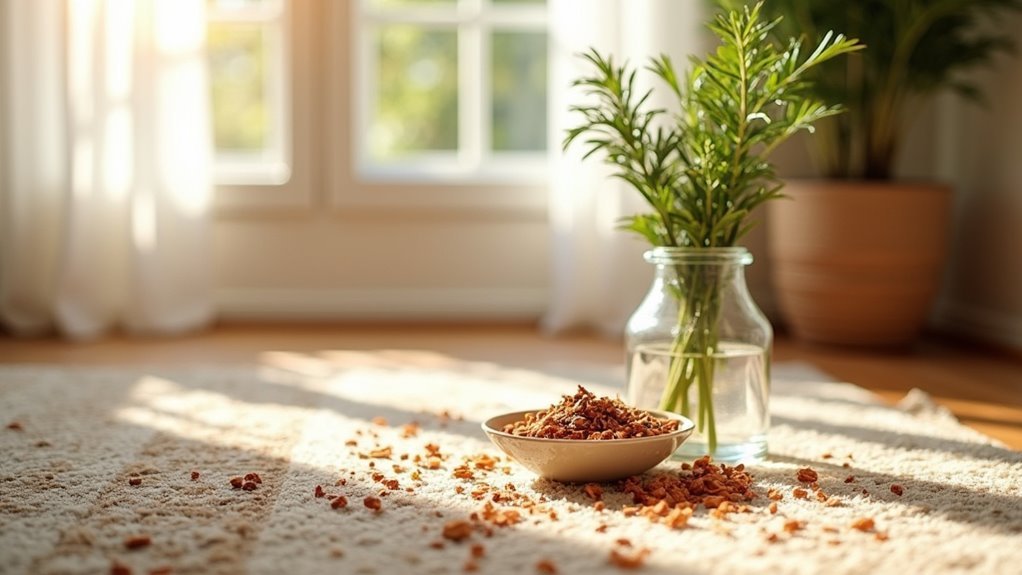You can control carpet beetles naturally using essential oils like peppermint and lavender as repellent sprays, food-grade diatomaceous earth to dehydrate larvae, and white vinegar solutions applied weekly in problem areas. Regular vacuuming with HEPA filters removes eggs and debris, while dried herb sachets in storage areas create hostile environments. Baking soda traps mixed with sugar attract and dehydrate larvae, and cedar blocks protect clothing naturally. These seven methods offer thorough protection that’ll transform your pest management approach.
Essential Oils as Natural Carpet Beetle Repellents

While chemical pesticides might seem like the obvious solution, essential oils offer a powerful and natural way to repel carpet beetles from your home.
Peppermint oil, clove, and lavender contain strong compounds that disrupt carpet beetle behavior, making them less likely to infest treated areas. You can create a diluted mixture and spray it on carpets, upholstery, and potential hiding spots where these pests gather.
Essential oils like peppermint, clove, and lavender create powerful natural barriers that effectively disrupt carpet beetle behavior and prevent infestations.
This non-toxic approach keeps your family safe, especially around children and pets, while effectively deterring infestations.
Regular application serves as an excellent preventive measure, helping you maintain a beetle-free environment over time. Essential oils provide a safer alternative that doesn’t compromise your home’s air quality or your family’s health.
Diatomaceous Earth for Safe Pest Elimination
You’ll find diatomaceous earth stands out as one of the safest natural pest control options when you choose food-grade varieties that meet strict safety standards for household use.
Proper application involves sprinkling the powder strategically in beetle-prone areas and understanding timing requirements for maximum effectiveness.
Before handling DE, you’ll need to gather essential protective gear to prevent respiratory and skin irritation during the application process.
Food-Grade Safety Standards
When seeking a natural pest control solution that won’t compromise your family’s safety, food-grade diatomaceous earth stands out as an exceptional choice for eliminating carpet beetles. This non-toxic powder meets strict food safety standards, making it dramatically different from toxic pool-grade varieties that should never be used indoors.
You can confidently apply in affected areas knowing it’s recognized as safe for human consumption. This effective pest control method works by dehydrating beetles and larvae through their exoskeletons. Apply thin layers in carpets, rugs, and corners where beetles hide.
While non-toxic, you’ll still want protective gear when handling DE to prevent minor irritation to the skin and respiratory system. This simple precaution guarantees comfortable application.
Application Methods Guide
Proper application techniques maximize diatomaceous earth’s effectiveness against carpet beetles while minimizing cleanup hassles.
You’ll want to lightly dust affected carpets, rugs, and furniture using a duster or sifter for even coverage. Don’t over-apply – excessive buildup creates unnecessary mess while reducing effectiveness.
Always use food-grade diatomaceous earth since it’s safe around children and pets, unlike toxic pool-grade versions.
When you apply this natural remedy, wear a mask and gloves to avoid inhaling particles that can irritate your respiratory system.
Leave the dust in place for several days to eliminate both adult beetles and larvae.
After waiting, vacuum thoroughly and immediately dispose of the vacuum bag to prevent re-infestation from any surviving pests.
Protective Gear Requirements
Safety gear forms the foundation of responsible diatomaceous earth application, protecting you from potential health risks while maintaining the treatment’s effectiveness.
You’ll need protective gloves to prevent skin irritation from prolonged contact with DE particles. A dust mask is essential for safeguarding your respiratory system against fine particle inhalation that can cause throat and lung irritation.
Eye protection through safety goggles shields against dust particles that could irritate your eyes during application. Wear long sleeves and pants to minimize skin exposure in infested areas.
Guarantee proper ventilation in your workspace to reduce airborne particles and create a safer environment. This protective approach lets you apply diatomaceous earth confidently while eliminating carpet beetles naturally.
Vinegar Solutions to Deter Carpet Beetle Infestations
You’ll find that white vinegar offers an effective, non-toxic approach to carpet beetle control through a simple spray solution.
The key lies in understanding proper application methods and targeting specific areas where these pests commonly gather and feed.
Most importantly, you need to know how vinegar affects carpet beetle larvae, which cause the actual damage to your fabrics and materials.
White Vinegar Spray Recipe
Since carpet beetles are naturally repelled by acidic scents, white vinegar becomes one of your most effective and affordable weapons against these fabric-destroying pests.
You’ll create this powerful deterrent by mixing equal parts distilled white vinegar and water in a spray bottle. This natural cleaner not only repels carpet beetles but eliminates potential food sources they seek.
Focus your application on high-traffic areas and dark corners where these pests typically hide. Guarantee thorough coverage for maximum effectiveness, then allow complete drying to prevent moisture buildup that attracts other insects.
The vinegar’s strong scent lingers temporarily but dissipates as surfaces dry.
Apply this solution weekly to maintain a pest-free environment and prevent future infestations from establishing in your home.
Application Methods and Areas
Three strategic application zones maximize your vinegar solution’s effectiveness against carpet beetle infestations.
First, target high-traffic areas where larvae commonly feed and breed. Apply the vinegar solution directly to corners and spaces under furniture, disrupting their hiding spots.
Second, spray window sills and entry points regularly to prevent adult carpet beetles from entering your home. The strong scent creates an effective barrier.
Third, treat carpets and upholstery systematically with your vinegar with water mixture. For ideal results, combine this approach with essential oils and diatomaceous earth to create extensive pest control.
Always ventilate the area after application, as the lingering smell repels beetles while cleaning surfaces throughout your home.
Effectiveness Against Larvae
Although adult carpet beetles pose minimal threat to your belongings, the larvae stage demands immediate attention as these destructive pests actively consume natural fibers, pet hair, and organic debris throughout your home.
Vinegar solutions effectively repel carpet beetle larvae through their strong smell, which disrupts the pests’ preferred environment. You’ll find that equal parts distilled white vinegar and water create an ideal mixture for targeting these destructive insects.
The acidic properties excel at cleaning surfaces while eliminating food sources that sustain larvae populations. This dual action helps reduce likelihood of survival and establishment.
Using vinegar solutions as a preventive measure keeps infestations from developing. While vinegar proves effective against larvae, you should combine it with other cleaning methods for thorough results when managing carpet beetle populations.
Thorough Vacuuming and Deep Cleaning Methods
When carpet beetles invade your home, implementing thorough vacuuming and deep cleaning methods becomes your first line of defense against these persistent pests.
Focus your vacuuming efforts on carpets, rugs, and upholstery, particularly targeting dark corners and hidden areas where larvae thrive. You’ll need a HEPA filter vacuum to capture tiny eggs effectively, and you must dispose of vacuum bags immediately to prevent reinfestation.
Steam cleaning provides excellent deep cleaning results, using high temperatures to eliminate carpet beetles, larvae, and eggs from carpets and upholstery.
Don’t neglect baseboards, corners, and spaces under furniture where debris accumulates. Complement these natural remedies by washing clothing and linens in hot water, removing potential food sources that attract these destructive insects.
Dried Herbs and Natural Storage Deterrents

Since carpet beetles rely heavily on their sense of smell to locate food sources and nesting sites, you can exploit this weakness by strategically placing dried herbs throughout your storage areas.
Target carpet beetles’ strongest sense by strategically positioning aromatic dried herbs in storage spaces where they typically search for food and shelter.
Bay leaves, rosemary, and lavender work exceptionally well as storage deterrents because their strong scents repel carpet beetles effectively. You’ll want to create sachets filled with these dried herbs and position them in drawers, wardrobes, and under furniture to establish a protective barrier.
Cedar chips offer another excellent option, releasing natural oils that continuously repel carpet beetles.
For enhanced protection, mix essential oils with water in spray bottles to create an additional protective layer on fabrics and surfaces.
Remember that regularly renewing your dried herbs every few months maintains their potency and guarantees ongoing effectiveness against infestations.
Baking Soda Traps for Larvae Control
While dried herbs create protective barriers against adult beetles, baking soda traps target the destructive larvae stage directly by exploiting their feeding behavior. This natural remedy works by dehydrating carpet beetle larvae when ingested, making it an effective control method.
Create your trap by sprinkling generous amounts of baking soda in areas where larvae congregate, particularly under furniture and along baseboards.
Mix baking soda with sugar to create an irresistible food source that attracts larvae while delivering lethal dehydration. Replace the mixture regularly since moisture reduces its effectiveness.
Remember that baking soda traps alone won’t eliminate infestations completely.
You’ll need to combine this approach with other cleaning methods like thorough vacuuming and washing infested items for thorough carpet beetle control.
Cedar and Natural Fiber Protection Strategies

Beyond targeting larvae directly, you can create long-term protection by leveraging cedar’s natural repellent properties and making strategic choices about fiber materials in your home.
Cedar chips or blocks placed in closets effectively deter carpet beetles through natural oils. Store clothing in airtight containers lined with cedar for dual protection against moisture and pest access. Cedar oil sprays applied to carpets maintain protective barriers while adding pleasant scents.
Consider replacing natural fibers like wool and cotton with synthetic alternatives, as carpet beetles prefer organic materials.
When storing natural fiber items, use storage boxes in well-ventilated storage areas rather than dark, undisturbed spaces where beetles breed. These protection strategies create an inhospitable environment that discourages infestations long-term.
Frequently Asked Questions
Is There a Natural Way to Get Rid of Carpet Beetles?
You can eliminate carpet beetles naturally by spraying equal parts vinegar and water on affected areas, vacuuming regularly, using diatomaceous earth in crevices, and steam cleaning carpets at high temperatures.
How Do I Get Rid of Carpet Beetles Asap?
You’ll need immediate action: vacuum thoroughly focusing on dark areas, spray vinegar-water solution on affected spots, apply food-grade diatomaceous earth along baseboards, and steam clean carpets using high temperatures.
What Scent Keeps Carpet Beetles Away?
You’ll find that strong scents like peppermint, clove, and lavender essential oils effectively repel carpet beetles. Vinegar’s powerful smell also works well, while bay leaves and other dried herbs create natural barriers.
How Do You Make Homemade Carpet Beetle Spray?
Mix equal parts distilled white vinegar and water in a spray bottle. Add a few drops of peppermint or clove essential oil for enhanced effectiveness. Test on fabric first, then spray affected areas regularly.
In Summary
You’ve now got seven powerful natural methods to tackle carpet beetles without harsh chemicals. Remember, consistency is key—you’ll need to combine multiple approaches for best results. Don’t wait until the infestation spreads; start implementing these remedies immediately. Regular maintenance using these natural solutions will keep your home beetle-free while protecting your family and pets from toxic pesticides. Take action today and reclaim your carpets naturally.





Leave a Reply